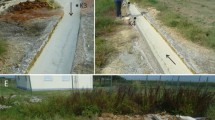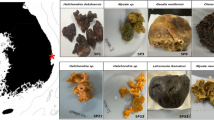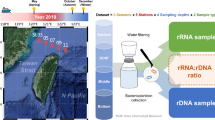Abstract
The stromatolites at Shark Bay, Western Australia, are analogues of some of the oldest evidence of life on Earth. The aim of this study was to identify and spatially characterize the specific microbial communities associated with Shark Bay intertidal columnar stromatolites. Conventional culturing methods and construction of 16S rDNA clone libraries from community genomic DNA with both universal and specific PCR primers were employed. The estimated coverage, richness and diversity of stromatolite microbial populations were compared with earlier studies on these ecosystems. The estimated coverage for all clone libraries indicated that population coverage was comprehensive. Phylogenetic analyses of stromatolite and surrounding seawater sequences were performed in ARB with the Greengenes database of full-length non-chimaeric 16S rRNA genes. The communities identified exhibited extensive diversity. The most abundant sequences from the stromatolites were α- and γ-proteobacteria (58%), whereas the cyanobacterial community was characterized by sequences related to the genera Euhalothece, Gloeocapsa, Gloeothece, Chroococcidiopsis, Dermocarpella, Acaryochloris, Geitlerinema and Schizothrix. All clones from the archaeal-specific clone libraries were related to the halophilic archaea; however, no archaeal sequence was identified from the surrounding seawater. Fluorescence in situ hybridization also revealed stromatolite surfaces to be dominated by unicellular cyanobacteria, in contrast to the sub-surface archaea and sulphate-reducing bacteria. This study is the first to compare the microbial composition of morphologically similar stromatolites over time and examine the spatial distribution of specific microorganismic groups in these intertidal structures and the surrounding seawater at Shark Bay. The results provide a platform for identifying the key microbial physiology groups and their potential roles in modern stromatolite morphogenesis and ecology.
Similar content being viewed by others
Log in or create a free account to read this content
Gain free access to this article, as well as selected content from this journal and more on nature.com
or
Accession codes
Accessions
GenBank/EMBL/DDBJ
References
Abed RMM, Kohls K, de Beer D . (2007). Effect of salinity changes on the bacterial diversity, photosynthesis and oxygen consumption of cyanobacterial mats from an intertidal flat of the Arabian Gulf. Environ Microbiol 9: 1384–1392.
Allwood AC, Walter MR, Balz S, Kamber BS, Marshall CP, Burch IW . (2006). Stromatolite reef from the Early Archaean era of Australia. Nature 441: 714–718.
Al-Qassab S, Lee WJ, Murray S, Simpson AGB, Patterson DJ . (2002). Flagellates from stromatolites and surrounding sediments in Shark Bay, Western Australia. Acta Protozool 41: 91–144.
Arp G, Reimer A, Reitner J . (2001). Photosynthesis-induced biofilm calcification and calcium concentrations in Phanerozoic oceans. Science 292: 1701–1704.
Awramik SM, Riding R . (1988). Role of algal eukaryotes in subtidal columnar stromatolite formation. Proc Natl Acad Sci USA 85: 1327–1329.
Bauld J, Chambers LA, Skyring GW . (1979). Primary productivity, sulfate reduction and sulfur isotope fractionation in algal mats and sediments of Hamelin Pool, Shark Bay, W.A. Aust J Mar Freshw Res 30: 753–764.
Benlloch S, López-López A, Casamayor EO, Øvreås L, Goddard V, Daae FL et al. (2002). Prokaryotic genetic diversity throughout the salinity gradient of a coastal solar saltern. Environ Microbiol 4: 349–360.
Brading M, Boyle J, Lappin-Scott H . (1995). Biofilm formation in laminar flow using Pseudomonas fluorescens EX 101. J Ind Microbiol 15: 297–304.
Burns BP, Goh F, Allen M, Neilan BA . (2004). Microbial diversity of extant stromatolites in the hypersaline marine environment of Shark Bay, Australia. Environ Microbiol 6: 1096–1101.
Burns BP, Seifert A, Goh F, Pomati F, Jungblut A-D, Serhat A et al. (2005). Genetic potential for secondary metabolite production in stromatolite communities. FEMS Microbiol Lett 243: 293–301.
Byerly GR, Lower DR, Walsh MM . (1986). Stromatolites from the 3,300–3,500-Myr Swaziland Supergroup, Barberton Mountain Land, South Africa. Nature 319: 489–491.
Chao A . (1984). Non-parametric estimation of the number of classes in a population. Scand J Stat 11: 265–270.
Characklis W . (1990). Process analysis. In: Characklis W, Marshall K (eds). Biofilms. John Wiley & Sons, Inc.: New York. pp 50–51.
Cole JR, Chai B, Marsh TL, Farris RJ, Wang Q, Kulam SA et al. (2003). The Ribosomal Database Project (RDP-II): previewing a new autoaligner that allows regular updates and the new prokaryotic taxonomy. Nucleic Acids Res 31: 442–443.
DasSarma S, Fleischmann EM, Rodriguez-Valera F . (1995). Halophiles. In: Rob FT (ed). Archaea: A Laboratory Manual. CSHL Press: Cold Spring Harbour, USA, pp 225–230.
DeLong EF . (1992). Archaea in coastal marine environments. Proc Natl Acad Sci USA 89: 5685–5689.
DeSantis TZ, Hugenholtz P, Larsen N, Rojas M, Brodie EL, Keller K et al. (2006). Greengenes, a chimera-checked 16S rRNA gene database and workbench compatible with ARB. Appl Environ Microbiol 72: 5069–5072.
Dravis JJ . (1983). Hardened subtidal stromatolites, Bahamas. Science 219: 385–386.
Garcia-Pichel F, Nubel U, Muyzer G . (1998). The phylogeny of unicellular, extremely halotolerant cyanobacteria. Arch Microbiol 169: 469–482.
Goh F, Leuko S, Allen MA, Bowman JP, Kamekura M, Neilan BA et al. (2006). Halococcus hamelinensis sp. nov., a novel halophilic archaeon isolated from stromatolites in Shark Bay, Australia. Int J Syst Evol Microbiol 56: 1323–1329.
Good IJ . (1953). The population frequencies of species and the estimation to the population parameters. Biometrika 40: 237–264.
Hoffman P . (1976). Stromatolite morphogenesis in Shark Bay, Western Australia. In: Walter MR (ed). Stromatolites. Elsevier Scientific Publishing Company: Amsterdam. pp 261–272.
Huber T, Faulkner G, Hugenholtz P . (2004). Bellerophon; a program to detect chimeric sequences in multiple sequence alignments. Bioinformatics 20: 2317–2319.
Jackson CR, Churchill PF, Roden EE . (2001). Successional changes in bacterial assemblage structure during epilithic biofilm development. Ecology 82: 555–566.
Javor BJ . (1988). CO2 fixation in halobacteria. Arch Microbiol 149: 433–440.
Jungblut AD, Hawes I, Mountfort D, Hitzfeld B, Dietrich DR, Burns BP et al. (2005). Diversity within cyanobacterial mat communities in variable salinity meltwater ponds of McMurdo Ice Shelf, Antarctica. Environ Microbiol 7: 519–529.
Leuko S, Allen MA, Goh F, Burns BP, Walter MR, Neilan BA . (2007). Analysis of intergenic spacer region length polymorphisms to investigate the halophilic archaeal diversity of stromatolites and microbial mat. Extremophiles 11: 203–210.
Logan BW, Cebulski DE . (1970). Carbonate sedimentation and environments, Shark Bay, Western Australia. Mem Amer Assoc Petrol Geol 13: 1–37.
Lowe DR . (1980). Stromatolites 3,400-Myr old from the Archean of Western Australia. Nature 284: 441–443.
Ludwig W, Strunk O, Westram R, Richter L, Meier H, Yadhukumar et al. (2004). ARB: a software environment for sequence data. Nucleic Acids Res 32: 1363–1371.
Macintyre IG, Prufert-Bebout L, Reid RP . (2000). The role of endolithic cyanobacteria in the formation of lithified laminae in Bahamian Stromalites. Sedimentology 47: 915–921.
Michaelis W, Seifert R, Nauhaus K, Treude T, Thiel V, Blumenberg M et al. (2002). Microbial reefs in the Black Sea fueled by anaerobic oxidation of methane. Science 297: 1013–1015.
Neilan BA, Burns BP, Relman D, Lowe DR . (2002). Molecular identification of cyanobacteria associated with stromatolites from distinct geographical locations. Astrobiology 2: 271–280.
Nicholson WL . (2002). Roles of Bacillus endospores in the environment. Cell Mol Life Sci 59: 410–416.
Nubel U, Garcia-Pichel F, Clavero E, Muyzer G . (2000). Matching molecular diversity and ecophysiology of benthic cyanobacteria and diatoms in communities along a salinity gradient. Environ Microbiol 2: 217–226.
Papineau D, Walker JJ, Mojzsis SJ, Pace NR . (2005). Composition and structure of microbial communities from stromatolites of Hamelin Pool in Shark Bay, Western Australia. Appl Environ Microbiol 71: 4822–4832.
Playford PE, Cockbain AE . (1976). Modern algal stromatolites at Hamelin Pool, a hypersaline barred basin in Shark Bay, Western Australia. In: Walter MR (ed). Stromatolites. Elsevier Scientific Publishing Company: Amsterdam, 101 p.
Reid RP, Visscher PT, Decho AW, Stolz JF, Bebout BM, Dupraz C et al. (2000). The role of microbes in accretion, lamination and early lithification of modern marine stromatolites. Nature 406: 989–992.
Retief JD . (2000). Phylogenetic analysis using PHYLIP. Methods Mol Biol 132: 243–258.
Rippka R, Waterbury JB, Stanier RY . (1981). Isolation and purification of cyanobacteria: some general principles. In: Staff MP, Stolp HG, Truper HG, Barlows A, Schlegel HG (eds). The Prokaryotes. Springer-Verlag: Berlin. pp 212–220.
Sambrook J, Fritsch EF, Maniatis T . (1989). Molecular Cloning: a Laboratory Manual, 2nd edn, Cold Spring Harbor Laboratory Press: New York.
Santegoeds CM, Ferdelman TG, Muyzer G, Beer DD . (1998). Structural and functional dynamics of sulfate-reducing populations in bacterial biofilms. Appl Environ Microbiol 64: 3731–3739.
Schloss PD, Handelsman J . (2005). Introducing DOTUR, a computer program for defining operational taxonomic units and estimating species richness. Appl Environ Microbiol 71: 1501–1506.
Stevenson RJ . (1983). Effects of current and conditions simulating autogenically changing microhabitats on benthic diatom immigration. Ecology 64: 1515–1524.
Tillett D, Neilan B . (2000). Xanthogenate nucleic acid isolation from cultured and environmental cyanobacteria. J Phycol 36: 251–258.
Visscher PT . (2000). Microscale observations of sulfate reduction: correlation of microbial activity with lithified micritic laminae in modern marine stromatolites. Geology 28: 919–922.
Visscher PT, Gritzer RF, Leadbetter ER . (1999). Low-molecular-weight sulfonates, a major substrate for sulfate reducers in marine microbial mats. Appl Environ Microbiol 65: 3272–3278.
Visscher PT, Reid RP, Bebout BM, Hoeft SE, Macintyre IG, Junior JAT . (1998). Formation of lithified micritic laminae in modern marine stromatolites (Bahamas): the role of sulfur cycling. Am Mineral 83: 1482–1493.
Wais AC . (1988). Recovery of halophilic archaebacteria from natural environments. FEMS Microbiol Ecol 53: 211–216.
Walter MR, Buick R, Dunlop JSR . (1980). Stromatolites 3,400-3,500 Myr old from the North Pole area, Western Australia. Nature 284: 443–445.
Wieland A, Kuhl M . (2006). Regulation of photosynthesis and oxygen consumption in a hypersaline cyanobacterial mat (Camargue, France) by irradiance, temperature and salinity. FEMS Microbiol Ecol 55: 195–210.
Acknowledgements
The Australian Research Council and the National Science Foundation (US) are thanked for their financial support for this project.
Author information
Authors and Affiliations
Corresponding author
Rights and permissions
About this article
Cite this article
Goh, F., Allen, M., Leuko, S. et al. Determining the specific microbial populations and their spatial distribution within the stromatolite ecosystem of Shark Bay. ISME J 3, 383–396 (2009). https://doi.org/10.1038/ismej.2008.114
Received:
Revised:
Accepted:
Published:
Issue date:
DOI: https://doi.org/10.1038/ismej.2008.114
Keywords
This article is cited by
-
Metagenomic, (bio)chemical, and microscopic analyses reveal the potential for the cycling of sulfated EPS in Shark Bay pustular mats
ISME Communications (2022)
-
Correlation between the spatial distribution and colony size was common for monogenetic bacteria in laboratory conditions
BMC Microbiology (2021)
-
Microbial diversity in a coastal environment with co-existing upwelling and mud-banks along the south west coast of India
Molecular Biology Reports (2019)
-
Functional shifts in microbial mats recapitulate early Earth metabolic transitions
Nature Ecology & Evolution (2018)
-
Arsenic metabolism in high altitude modern stromatolites revealed by metagenomic analysis
Scientific Reports (2017)



